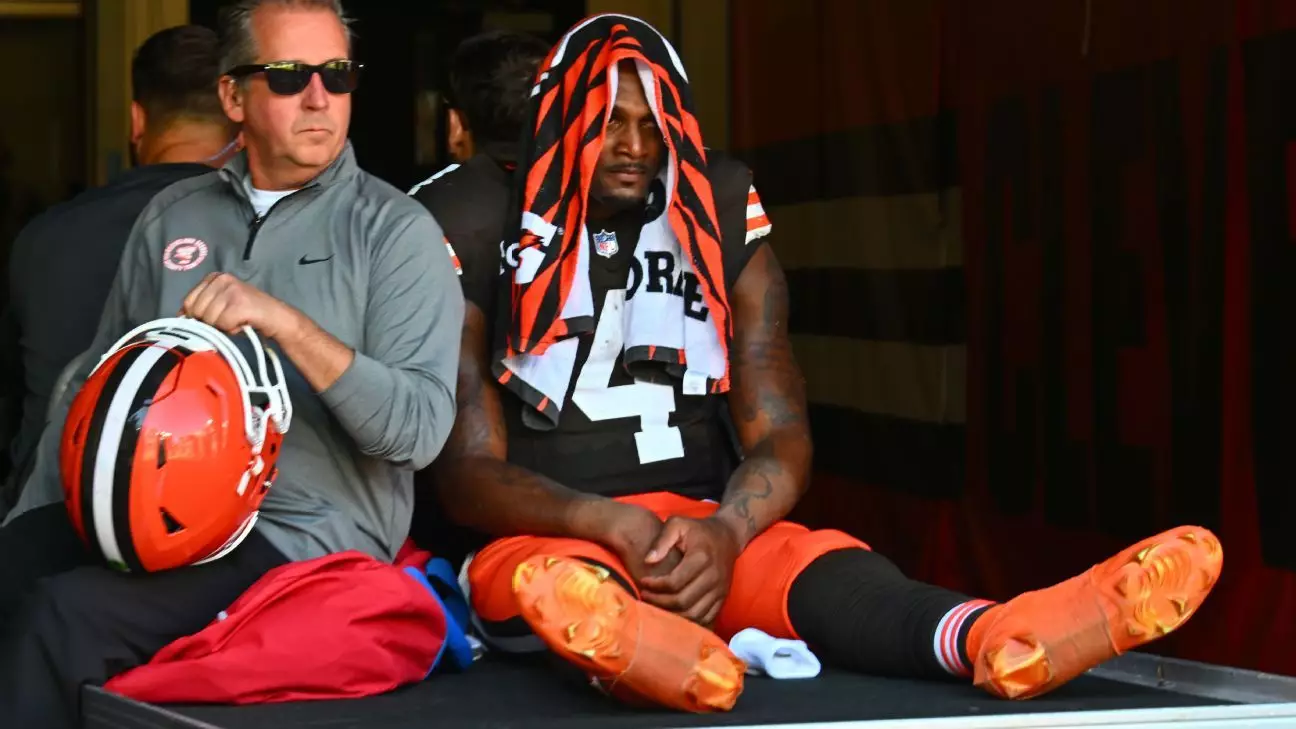On a somber Monday, the Cleveland Browns confirmed what many had feared following their recent loss to the Cincinnati Bengals: quarterback Deshaun Watson will miss the rest of the season due to a ruptured right Achilles tendon. This devastating injury not only redirects the course of Watson’s personal aspirations but also places the entire franchise in a precarious position as it grapples with yet another setback in a series of unfortunate events for both player and team.
Watson sustained the injury during a seemingly innocuous play, his leg hyperextending without any physical contact as he attempted to carry the ball. The abruptness of the injury and the need for a cart to transport him off the field underscored the trauma of the moment. Players and coaches alike reacted with visible distress; the emotional weight of seeing a teammate endure such a severe setback resonated throughout the Browns’ locker room. Observations made post-game revealed stark contrasts in fan behavior—while players showed empathy, some fans unfortunately erupted in cheers when Watson went down. This reaction prompted strong rebukes from both head coach Kevin Stefanski and defensive end Myles Garrett, who emphasized the importance of showing respect for injured players, regardless of their on-field performance or past controversies.
With Watson sidelined, the baton was passed to second-year quarterback Dorian Thompson-Robinson. However, his performance was far from reassuring, with a completion rate of just 45.8%, yielding a meager 82 yards and two interceptions. Adding to the chaos, Thompson-Robinson sustained a finger injury late in the game, leading to his replacement by Jameis Winston, who showcased a mixed bag of results himself. As the Browns readjust their game plan in the wake of Watson’s injury, they face the daunting challenge of solidifying their quarterback situation. Coach Stefanski’s hesitance to name a starter for the upcoming game against the Baltimore Ravens echoes their uncertainty—will he back Thompson-Robinson, or lean on Winston for stability?
Deshaun Watson’s trajectory in Cleveland has been laden with complexities. Despite the promise he held upon joining the Browns, the past three seasons have been riddled with setbacks, culminating in this latest injury. While Watson’s performance prior to the injury showcased some glimpses of potential—he finished the Bengals game with 15 completions on 17 attempts for 128 yards—the reality is that his overall record has been disappointing since his lucrative $230 million deal. With just 19 starts to his name since the trade, questions loom about whether the organization has made a grave financial mistake.
Watson’s history of injuries dates back to his college days at Clemson and extends into his tenure with the Houston Texans, where previous knee injuries caused significant disruptions. The cumulative weight of these injuries, combined with the external distractions of his off-field controversies, including an 11-game suspension due to serious allegations, cast a long shadow over his potential legacy as a premier quarterback.
As the Cleveland Browns move forward, Watson’s injury highlights not only concerns about player safety but also raises questions about the team’s overall structure and future direction. Financially tied to a quarterback who is unproven as a franchise leader, the Browns’ management is now at a crossroads. With $46 million still owed to Watson over the next two seasons and a staggering $72.9 million cap hit looming in 2025, the organization must navigate these tumultuous waters carefully.
Ultimately, the frustration felt by fans and players alike becomes more pertinent in the context of a franchise that has seen more downs than ups in recent years. The collective sentiment validates the need for unity and support among the team, but it also emphasizes the necessity for clear communication and reform in fan expectations and behavior. As the Browns approach the remainder of the season without their starting quarterback, they must recalibrate—not only their strategy but also the cultural atmosphere surrounding the team, ensuring they foster resilience in the face of adversity.


Leave a Reply